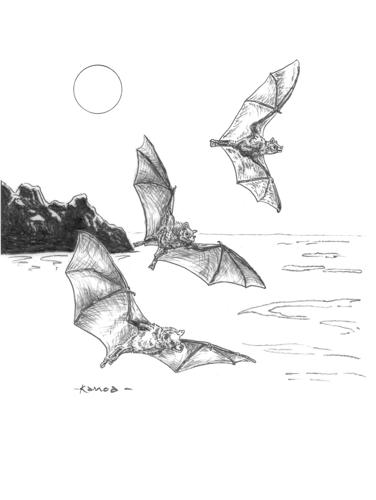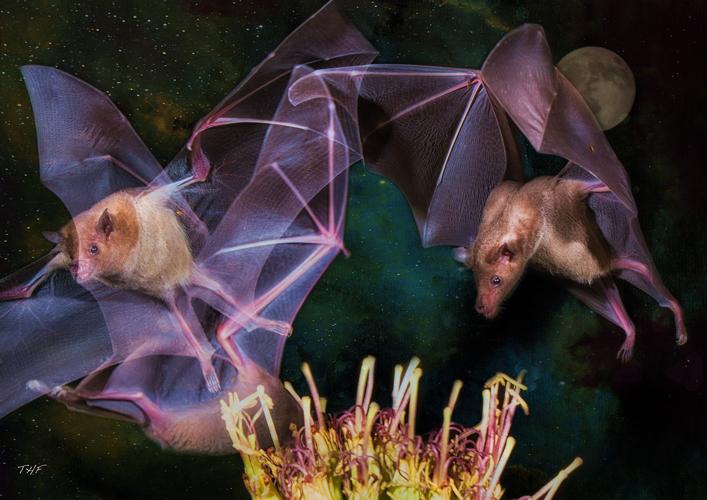The most biologically diverse desert in the world, the Sonoran Desert hosts four species of columnar cacti which, along with their pollinators, have been the subject of an 11-year study by Dr. Theodore Fleming. “No Species Is an Island” describes his surprising results, including the ability of organ pipe cactus to produce fruit with another species’ pollen and the highly specialized moth-cactus pollination system of the senita. With illustrations by Kim Kanoa Duffek, Fleming’s book offers an insightful look at how field ecologists work and at the often big surprises that come from looking carefully at a natural world where no species stands alone.
An Introduction
For 11 years (1989–99), my research team of volunteer assistants, graduate students, colleagues, and I made an annual spring sojourn to a small patch of desert to learn some of its secrets.
Like a migrant bird that unerringly returns year after year to the same place to build its nest and raise its young, I returned to a site near the small fishing village of Bahia de Kino (Kino Bay) on the Sea of Cortez (Gulf of California) in Sonora, Mexico. Inspired by John Steinbeck and his explorations of the Gulf, recounted in his famous Log from the Sea of Cortez, I dubbed this site Tortilla Flats.
The initial impetus for our work at Kino Bay came from Merlin Tuttle, the founder and then executive director of Bat Conservation International, who had visited Kino Bay in 1988 to photograph the nectar-feeding bat Leptonycteris yerbabuenae (the lesser long-nosed bat) pollinating flowers of three species of columnar cacti for an article in National Geographic.
This bat had recently been classified as an endangered species in the United States (where its historic range includes southern Arizona) and Mexico (where it occurs widely in the arid lowlands), so there was now some urgency to determine more fully its conservation status and its importance as a pollinator of Sonoran Desert columnar cacti and century plants (agaves). In August 1988, Merlin invited me to join him to study this charismatic bat-plant interaction the next spring.
Once I set foot in the Sonoran Desert, a new habitat for me, I became enthralled by its plants and animals.
Even better, as our work began, we started to make intriguing new discoveries as the Sonoran Desert revealed some of its biological secrets to us. And by studying Tortilla Flats year after year, I gained important insights into its conservation value.
Little did we know in 1989 that this modest piece of desert, degraded as it was from decades of overgrazing by cattle, harbors an unusually large number of biological secrets. Discovering these secrets was a Christmas-like experience for me. Imagine the excitement of making totally unexpected discoveries every time you begin a new study! Tortilla Flats may not be an unusual piece of desert, but the secrets that its inhabitants revealed to us have certainly been far from ordinary.
Some pollinators run marathons most days of their lives
One of my many pleasures in working at Tortilla Flats was wandering among the giant cacti at night listening and looking for Leptonycteris bats. Compared with other night sounds in the desert, including the yips and howls of coyotes and the bubbly calls of western screech owls, bat sounds are pretty subtle. But this bat is a strong flier and its wings make a characteristic “swooshing” sound as they cut through the air.
I loved to see and hear these wonderful bats as they made fleeting visits to the ghostlike flowers of cardon or saguaro far above me whenever I slept under a cactus at night. More recently, I can hear these sounds in my own backyard in Tucson when Leptos are visiting my hummingbird feeders in late summer and early fall.
Like many (but not all) of the pollinators of these cacti, Lepto is a migrant visitor to the Sonoran Desert. Many pregnant females (but few males) migrate from as far away as southwestern Mexico to form maternity colonies containing tens of thousands to over 100,000 bats in caves and abandoned mines in northwestern Sonora and southwestern Arizona each spring. Babies are born in these roosts beginning in mid-May, and they nurse for over a month before they can fly and feed for themselves. Just how far these females migrate and how far they commute from their day roosts to their feeding grounds each night were unknown when we began our studies at Tortilla Flats. Again, the answers in both cases turned out to be surprising.
First, let’s consider how far these bats migrate. The traditional way to study the migratory behavior of bats (and birds and monarch butterflies) has been to place numbered bands or tags on thousands of individuals with the hope of recapturing some of them someplace else. As you can imagine, this is a very labor-intensive business, and long-distance banding recoveries are very rare for most species. Instead of banding lots of bats, we used genetic data to tell us where these migrant bats are coming from. To do this, we clipped and preserved in alcohol a tiny piece of wing membrane from Leptos that we captured in nylon mist nets (this process does not harm the bats) and analyzed the genetic composition of the mitochondrial DNA contained in this tissue.
Mitochondria are the tiny organelles in all cells that are involved in chemical energy production. Unlike the cell’s nucleus, which contains most of the body’s DNA and genes, mitochondria contain a small amount of DNA (and a few genes) that passes directly from mothers to their offspring without ever combining with a father’s DNA during fertilization.
After analyzing mitochondrial DNA samples from many Lepto roosts throughout western Mexico and southern Arizona, we then looked for genetic matches between roosts. Matches between bats in the northern maternity colonies and southern winter roosts, for instance, provide strong evidence of a migratory connection between these roosts. Using this approach, we learned that many bats roosting in northern Sonora and southern Arizona spend their winters as far away as coastal Jalisco, some 1,100 kilometers (700 miles) south of Tortilla Flats.
We’ve even analyzed tissue samples from bats captured in my backyard in Tucson and found that their mitochondrial genes also come from a cave off the coast of Jalisco. This is where many females mate with males in November and December.
So just to get to their spring birthing grounds, the Leptos visiting cardon and other cactus flowers at Tortilla Flats have had to travel a pretty fair distance, all the while developing a baby in their tummies.
Although this journey takes time and energy, it is worth it for pregnant females. The Sonoran Desert in the spring and early summer when columnar cacti are flowering and fruiting is much richer in food for plant-visiting bats than is the tropical dry forest near their mating caves in Jalisco. Once they reach the Sonoran Desert, females are in “fat city” in terms of food availability.
But Leptos’ long-distance travels don’t end when they reach their maternity caves, as we discovered when we began to glue (temporarily) tiny radio transmitters on the backs of bats that were feeding at cactus flowers in Tortilla Flats.
We fully expected our tagged Leptos to be roosting during the day in a cave in a small mountain about 6.4 kilometers (4 miles) west of Tortilla Flats. This was the only bat cave containing Leptos that we knew about at the beginning of our study in April 1989.
To our surprise, however, the tagged bats did not roost in this cave. Instead, when they finished feeding each night, they literally flew out to sea and roosted in one or more caves on the south end of Isla Tiburón, fully 24 kilometers (15 miles) from their feeding grounds. Night after night, our tagged bats faithfully flew across a narrow stretch of the Sea of Cortez to the mainland before heading south toward Tortilla Flats. Then they would add kilometer after kilometer of flight as they visited flowers in their large feeding areas. All told, they flew nearly 100 kilometers (about 60 miles) in commuting to and from “home” and while feeding each night.
But why do Leptos fly such great nightly distances? Why not feed closer to their day roosts or choose roosts closer to good feeding grounds?
One reason for this is that females appear to be quite selective about their maternity roosts. Not just any old cave or mine appears to be suitable for them. What they are apparently looking for in a maternity roost is safety (freedom from disturbance by humans and predators) and enough room for many individuals to roost together. By roosting in large numbers—and this behavior differs from that of nearly all of their nectar-feeding relatives—Leptos can warm up their cave or mine with their body heat. This allows them to spend the day at an air temperature (above 30°C or 86°F) at which their energy costs are minimal and at which their babies can grow quickly. By saving energy during the day, these bats have more energy to spend on foraging at night. Thus, they can afford to fly long distances to rich feeding grounds by selectively roosting in climatically advantageous caves.
Being a selective rooster means that Lepto has to have the physiological and anatomical machinery to fly long distances efficiently to reach its feeding grounds. Which, of course, it does.
I have handled many kinds of bats in my research, but I continue to be amazed at how muscular Lepto is. It is built like a lean marathon athlete: It has long, narrow wings for fast, efficient flight, and it lacks the friction-producing tail membrane (and tail) found in most other kinds of bats.
In contrast, the California leaf-nosed bat, an insect-eating relative of Lepto that also lives in the Sonoran Desert, is a wimp. It has a softly muscled body; short, broad wings; and a large tail membrane for slow, maneuverable flight as it plucks insects off desert plants. There is no way that this nonmigratory bat can perform the nightly and seasonal aerial athletics that Lepto does.
Lepto’s sleek body allows it to commute from its day roosts to its feeding grounds at speeds of over 48 kilometers (30 miles) per hour for one or more hours at low energetic cost. We have calculated, for example, that it costs a female only about eight visits to cardon flowers, removing about 10 milliliters (about 0.3 ounces) of nectar per visit, out of more than 100 total flower visits to pay for its (one-way) commute from Isla Tiburón to Tortilla Flats each night.
When flight costs are this cheap, a forager can afford to fly long distances when it is out shopping for food. These long flights, in turn, mean that the lesser long-nosed bat is an ideal pollinator for widely spaced desert plants such as columnar cacti. Compared with the cost of insect pollination, a plant must pay a relatively stiff price in terms of nectar and pollen per flower for bat pollination (about 1.5 milliliters of nectar and 0.5 grams of pollen, or 0.05 ounces and 0.02 ounces, respectively), but the potential payoff in terms of long-distance pollen (and seed) movement are substantial.
Our studies of the genetic composition of populations of Sonoran Desert columnar cacti clearly support the idea that Leptonycteris bats often move pollen (and seeds?) long distances among populations.
The lesson that Lepto teaches me, therefore, is that some pollinators are prodigious, extremely energy-efficient athletes. We often see the fleeting visits of bees, hummingbirds, or, more esoterically, lesser long-nosed bats to flowers (or to hummingbird feeders) without giving much thought to the efforts these animals have made simply to be at the place you observed them and how many kilometers they will place on their small wings each night and during their lifetimes. In the case of Lepto, for instance, I calculate roughly that if a female lives seven years, which is not unusual for this species, she will have flown about 225,000 kilometers (about 140,000 miles) in her lifetime and about 32,000 kilometers (about 20,000 miles) in a single year.
Scaled to her body length (about 8.9 centimeters or 3.5 inches), this female will fly about 2.6 billion body lengths in her life. Just imagine how much easier her life would be like if she could get some frequent flier miles to help subsidize some of this travel! And how many cactus flowers would be needed to provide the fuel for all of this flight? At an amazingly efficient fuel economy of about 48 kilometers (30 miles) per cactus flower (or 60,000 miles per gallon of cactus nectar!), our female Lepto will need to feed at the energetic equivalent of about 4,700 cactus flowers during her lifetime. That’s a lot of pollination by one bat!
In addition to providing us with important insights into the ecology and energetics of pollination and pollinators, this lesson teaches us a couple of important conservation lessons.
First, it teaches us that caves and mines that Lepto uses for roosts during its lifetime are critically important for its survival. These roosts include not only its mating caves in southern Mexico and its maternity caves and mines at the northern end of its range but also the roosts that it uses during migration. This species needs a series of roosts covering a distance of about 1,200 kilometers (750 miles) north-south in western Mexico and southern Arizona during its annual migration.
Disturbance or destruction of any of these roosts puts Lepto’s migration in danger. And, second, Lepto needs intact populations of food plants, including flowering columnar cacti in the spring and flowering century plants (agaves) in the fall, to fuel its migration as well as its daily energy requirements. Protecting its feeding grounds before, during, and after migration is therefore just as important as protecting its roosts if Lepto is to prosper indefinitely.








